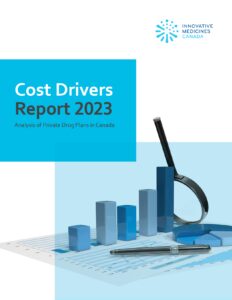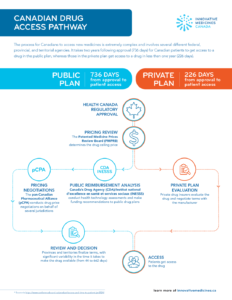Unlocking the Benefits
Private Drug Coverage’s Role in Canada’s Healthcare Landscape
The Value of Private Drug Coverage in Canada
More than 27 million – or nearly 70% – of Canadians depend on access to medicines and vaccines through private drug plans offered by their employer.
Most Canadians have prescription drug coverage through either public (government) drug plans or private (insurance) drug plans offered by their employers. According to a recent report from the Conference Board of Canada, 97.2% (ref. CBoC Gap 2.0) of Canadians are eligible for drug coverage.
Value in the Workplace
Many employers provide private drug plans as part of the total compensation package offered to employees. Investing in employee health is seen by many employers as a valuable strategy to attract and retain top talent, and reduces employee absenteeism and disability claims.
Read more
By positively impacting presenteeism through comprehensive private drug plans, employers can also promote better employee engagement which helps to create a healthier and more productive workplace.
Read less
Value Of Innovation And Comprehensive Access
New discoveries continue to enable healthcare professionals to effectively treat and even prevent some of the most challenging diseases. As the drug discovery process improves, new treatments will become available to address previously untreatable conditions.
Read more
Incremental innovation consists of a series of small improvements made to existing medicines that can lead to improvements in quality of life and adherence. When a new drug is added to an existing therapy class, it can offer alternatives to meet diverse patient needs.
Incremental improvements to existing therapies and diversity of treatment options can have transformative effects on individuals’ health and lifestyle as patients often respond differently to different medicines for the same condition. Some of these treatments can help people who would otherwise have limited or no options, or for whom the first line of therapy failed.
Offering multiple treatment options for the same condition provides better health outcomes often without an increase in cost. Breadth of access to new medicines is a key value of private drug coverage plans.
Read less
Value Of Managing Risk
As more complex and specialized medicines come to market, there is an increased need for plan sponsors to effectively manage risk. Small plan sponsors outside of Quebec who purchase fully insured coverage plans can be particularly vulnerable to the financial impact of high-cost drug claims.
Read more
These types of claims can potentially result in substantial increases in insurance premiums and pool charges.
To avoid these increases, plan sponsors often look to reduce the comprehensiveness of coverage by placing restrictions their drug plans to control costs. These measures may include limiting or influencing the choice of therapy, as well as limiting the amount of benefits payable to employees through annual or lifetime caps. These measures can save money in the short term but are unsustainable in the long term as they can limit access to treatments necessary for employees to return to work often resulting in long-term disability or other expensive consequences.
Risk management and pooling mechanisms are available to help spread the risk of unexpected high-cost claims across a larger population. Currently, outside of Quebec, participation in these mechanisms is voluntary and specific costs and calculation methodology are not shared publicly. In Quebec, all private plans with fewer than 6,000 covered lives are mandated to participate, and associated costs and calculation methodology are available publicly. As a result, small Quebec plan sponsors experience less volatility and are better protected against high-cost claims compared to the rest of Canada. Actions to modernize adequate and effective risk management and pooling outside of Quebec are becoming increasingly critical to preserving the quality of health benefits coverage for employees.
Read less

Private drug benefits offer significant value to Canadian employers and their employees as they typically provide faster and broader coverage of new medicines than public plans. Better access to treatments eases the burden on our healthcare system, by improving and supporting employee health, productivity, and engagement, while minimizing absenteeism, disability claims, disease progression and the need for costly health interventions.
Comparing Public to Private Drug Plans
Canadians are well-served by private drug plans, which offer twice as many medicines and significantly faster access to new medicines compared to public drug plans. This helps ensure that plan members and their families receive the most appropriate treatment at the right time.
It’s important to note that public drug plans offered by our Canadian health systems support different populations compared to private drug plans, most notably citizens over the age of 65 and those with access to other social programs. The purpose of public drug plans is to provide coverage within a fixed budget to achieve overall population health objectives and to minimize health system costs. They do not prioritize availability of optimal treatment, speed, or the impacts on workforce productivity.
Access Delays
For Canadians with public drug plan coverage, it takes two years, on average, for patients to get access to approved new medicines. This is much slower than many comparable countries across the globe. In fact, Canada ranks last in the G7 in the time it takes for new medicines to reach patients on public drug plans.

Access Erosion
Traditionally, private plans often made medicines available shortly after Health Canada safety approval. However, in recent years, there has been a growing trend of some private drug plans adopting health technology assessment (HTA) and other evaluation tools used by public plans to assess the value of new medicines. Use of these tools can decrease the comprehensiveness of private coverage by delaying or denying access to some new medicines that could provide significant benefits for Canadians.
Private drug plans serve a different population and meet different needs than public drug plans. Continuing to ensure faster and broader access to medicines is key for the effectiveness and value of private drugs plans for Canadians.

Analysis & Reports

Cost Drivers Report 2023
Annual cost growth in Canada’s private drug benefit market is driven by increased utilization and chronic disease drugs, with an increase in claimants post‑pandemic.
Read the full report.
Infographics & Data

Canadian Drug Access Pathway
The process for Canadians to access new medicines is extremely complex and involves several different federal, provincial, and territorial agencies. It takes two years following approval (736 days) for Canadian patients to get access to a drug in the public plan, whereas those in the private plan get access to a drug in less than one year (226 days).
News

Why managing risk more effectively is key for private drug plan sustainability
This article originally appeared in the Benefits and Pensions Monitor on September 5, 2023. ‘If the insurance industry doesn’t upgrade drug insurance […]

Pharmaceutical Benefits: Ensuring Value for Plan Sponsors
We need to work together to evolve the private market so that it continues to have the value of providing […]




